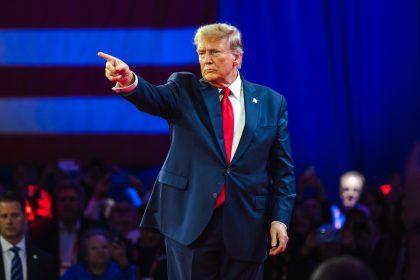While most people were enjoying a well-deserved Juneteenth holiday, the financial markets were having their own version of a restless day off. Stock futures decided to slide downward even though the actual markets were closed, proving that investor anxiety doesn’t take holidays even when investors do.
The numbers tell a story of nervous energy with nowhere to go. S&P 500 and Dow futures each dropped about 0.4%, while the Nasdaq took a bigger hit at 0.6%. These aren’t massive moves by any stretch, but they’re happening in a weird financial twilight zone where few people are actually trading, making every small movement feel more significant than it probably should.
It’s like having a conversation in an empty restaurant – every word carries more weight because there’s no background noise to absorb it. When trading volume is thin because of holidays, even minor shifts in sentiment can create price movements that might seem more dramatic than they really are.
The global worry parade that never stops
Even on a U.S. holiday, the world keeps spinning and creating reasons for investors to lose sleep. Federal Reserve signals are still echoing through trading algorithms, geopolitical tensions in the Middle East continue to simmer, and all of these concerns are bouncing around in a nearly empty trading environment like pinballs in a machine with most of the bumpers removed.
These global developments don’t pause for American holidays, which creates this strange dynamic where significant events are happening but most U.S. market participants are offline. It’s like getting important news while you’re in airplane mode – you know something’s happening, but you can’t fully process or respond to it until you’re back online.
The Middle East tensions in particular have a way of making investors nervous about everything from oil prices to broader market stability, regardless of whether those concerns are immediately justified. When traders are already on edge about other issues, geopolitical uncertainty becomes the thing that tips sentiment from cautious to genuinely worried.
The thin trading trap that amplifies everything
Holiday trading creates this bizarre financial environment where normal market dynamics get completely distorted. With fewer participants active, every trade has outsized impact, and price movements that would barely register on a normal trading day suddenly look like significant trends.
Think of it like trying to judge a restaurant’s popularity by watching who walks in during a snowstorm. The few people who show up might give you some information, but it’s not really representative of normal conditions. Holiday trading patterns often tell you more about the dedication of algorithmic trading systems than about genuine investor sentiment.
This amplification effect makes it particularly tricky to interpret what these futures movements actually mean for when markets reopen. Are investors genuinely more pessimistic about market conditions, or are we just seeing the financial equivalent of an echo in an empty room?
The speculation game with house money
With limited real economic data being released and most market participants taking the day off, trading activity becomes heavily influenced by speculation and global headlines rather than fundamental analysis. It’s like playing poker when most of the other players have left the table – the remaining participants are operating with different risk calculations and motivations.
Algorithmic trading systems don’t take holidays, so a significant portion of the activity is driven by computers responding to news headlines and technical indicators without the human judgment that might provide context or restraint. This can create price movements that reflect programmed responses rather than thoughtful market analysis.
The combination of speculation and algorithmic activity in thin trading conditions can produce price movements that look significant but may not reflect the broader market sentiment that will emerge when full participation returns.
The holding pattern that’s making everyone twitchy
Markets have been stuck in a frustrating holding pattern for weeks, waiting for clearer signals from central banks, better economic data, or resolution of various geopolitical concerns. This kind of uncertainty creates an environment where even minor developments get magnified because investors are desperately looking for anything that might indicate future direction.
The Federal Reserve’s recent signals have left many market participants unsure about the timeline and magnitude of potential policy changes. This uncertainty creates a backdrop where every piece of news gets analyzed for clues about what might happen next, even when that news might not be particularly relevant to monetary policy decisions.
Corporate earnings season is also approaching, which adds another layer of anticipation and anxiety. Investors are trying to position themselves for potential surprises while dealing with all the other uncertainties that have been weighing on market sentiment.
The Friday reopening that everyone’s watching
All eyes are now on Friday’s market reopening, when normal trading volume returns and investors can get a better sense of whether Thursday’s futures movements reflected genuine sentiment shifts or just the quirks of holiday trading. It’s like waiting for a real conversation after spending time texting – you need full engagement to understand what’s really going on.
The reopening will provide the first opportunity for full market participation to process all the global developments that occurred during the holiday period. This could lead to more significant price movements as pent-up trading activity and delayed reactions to news events get released into the market.
Analysts and investors will be watching closely to see whether the cautious sentiment reflected in Thursday’s futures trading carries over into normal market conditions, or if it was just an artifact of the unusual trading environment.
The volatility warning that applies to everything
The thin trading conditions serve as a reminder of how quickly market dynamics can change when normal participation patterns get disrupted. What seems like a minor decline in futures during holiday trading could easily reverse or amplify when full trading resumes, making it dangerous to read too much into any single day’s movements.
This volatility isn’t just about holiday trading – it reflects the broader uncertainty that’s been characterizing markets for months. When investors are already on edge about multiple issues, any disruption to normal trading patterns can create exaggerated reactions that don’t necessarily reflect underlying economic fundamentals.
The key lesson is that market movements during unusual conditions should be viewed with extra skepticism. Whether it’s holiday trading, major news events, or other disruptions to normal patterns, the immediate price action often tells you more about market mechanics than about genuine investment sentiment or economic prospects.

















